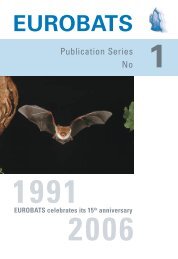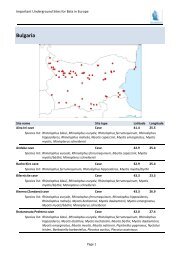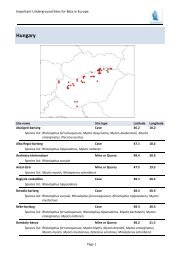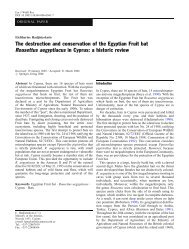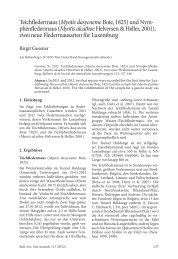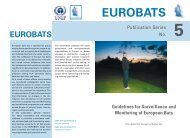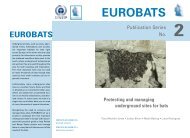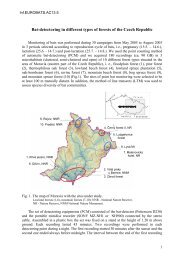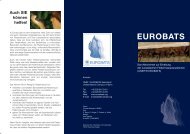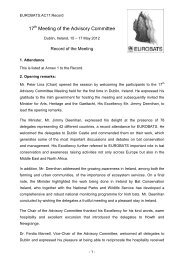4 Meeting of the Standing Committee 15 Meeting of the ... - Eurobats
4 Meeting of the Standing Committee 15 Meeting of the ... - Eurobats
4 Meeting of the Standing Committee 15 Meeting of the ... - Eurobats
You also want an ePaper? Increase the reach of your titles
YUMPU automatically turns print PDFs into web optimized ePapers that Google loves.
There are some o<strong>the</strong>r questions/problems that have to be solved. Until now only bat activity<br />
in a distance between 10 and 30 m from <strong>the</strong> radar has been studied, but recent rotors blades<br />
have a length <strong>of</strong> 40-50m. Additionally, nothing is known about possible impacts <strong>of</strong> radar on<br />
o<strong>the</strong>r species groups as insects or birds. Taking this information into consideration, radar is<br />
still yet not a satisfactory way to deter bats from wind turbine rotors. Never<strong>the</strong>less, its effect<br />
on bats was confirmed by Ahlén et al. (2009), who observed avoidance <strong>of</strong> an area around a<br />
lighthouse by bats when a navigation radar was on.<br />
Ahlen I, HJ Baagoe & L Bach (2009) Behavior <strong>of</strong> Scandinavian bats during migration and foraging at<br />
sea. Journal <strong>of</strong> Mammalogy 90 : 1318–1323.<br />
Nicholls B & P Racey (2007) Bats avoid radar installations: Could electromagnetic fields deter bats<br />
from colliding with wind turbines? PloS ONE 2(3): e297. doi:10.1371/journal.pone.0000297.<br />
Nicholls B & P Racey (2009) The Aversive Effect <strong>of</strong> Electromagnetic Radiation on Foraging Bats—A<br />
Possible Means <strong>of</strong> Discouraging Bats from Approaching Wind Turbines. PLoS ONE 4(7): e6246.<br />
doi:10.1371/journal.pone.0006246.<br />
9) Table on maximum foraging distances <strong>of</strong> species<br />
In <strong>the</strong> framework <strong>of</strong> <strong>the</strong> Environmental Impact Assessment <strong>of</strong> wind farm projects, it is<br />
important to know <strong>the</strong> range <strong>of</strong> <strong>the</strong> different species encountered in <strong>the</strong> vicinity and <strong>the</strong> height<br />
at which <strong>the</strong>y can fly. The following table presents this information for <strong>the</strong> different bat<br />
species which have been killed by wind turbines. For most species <strong>the</strong> information comes<br />
from radiotracking studies and <strong>the</strong> mentioned references are listed below <strong>the</strong> table.<br />
Species<br />
max foraging<br />
distance (km)<br />
Nyctalus noctula 26<br />
Height <strong>of</strong> flight<br />
(m)<br />
10 to a few<br />
hundred meters<br />
Nyctalus leisleri 17 above canopy<br />
Nyctalus lasiopterus 90<br />
Miniopterus schreibersii 40<br />
Pipistrellus nathusii 12<br />
Myotis myotis 25<br />
1300m (telescope<br />
& radar)<br />
2-5 (foraging) and<br />
open sky (transit)<br />
1-20 (foraging);<br />
30-50 (migration)<br />
1-<strong>15</strong>m (direct flight<br />
in open sky in<br />
transit)<br />
Myotis blythii 26 1-<strong>15</strong><br />
Myotis emarginatus 12,5 no information<br />
Myotis bechsteinii 2,5<br />
Pipistrellus pygmaeus<br />
1,7 (mean<br />
radius)<br />
1-5 and in <strong>the</strong><br />
canopy<br />
- 7 -<br />
References<br />
Radiotracking<br />
studies<br />
1, 7, 30 Yes<br />
5, 6, 30, 32,<br />
42, 45<br />
Yes<br />
2, 3, 4, 30 Yes<br />
8, 30, 41, 40 Yes<br />
43, 45, 46,<br />
47,30<br />
26, 27, 28,<br />
29, 30<br />
22, 23, 24,<br />
25, 26, 30<br />
17, 18, 30,<br />
33, 36, 38, 39<br />
12, 30, 31,<br />
38, 39<br />
Yes<br />
Yes<br />
Yes<br />
Yes<br />
Yes<br />
up to <strong>the</strong> rotor 20, 30 Yes<br />
Pipistrellus pipistrellus 5,1 up to <strong>the</strong> rotor 21, 61<br />
No;<br />
chimiolumi<br />
nescent<br />
tags



